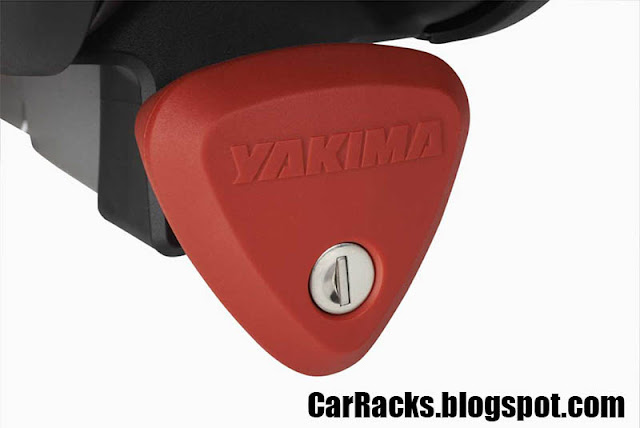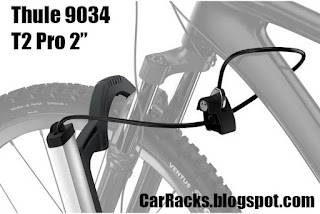The two most popular swing-away bike rack options on the market are the Thule 9027 Apex Swing and the Yakima FullSwing (redesigned in 2014 from an earlier model also called the Yakima FullSwing). In this review, I will go through some of the pros and cons of each model and some tips from my own experience selling, assembling, installing, and using them both.
Yakima FullSwing
 |
| Yakima FullSwing top arm and ZipStrip |
The top arms of the arm fold flat against the upright mast when not in use using a red handle at the top of the rack. It's not the easiest handle like Thule has, but this is also not a frequently used feature compared to the loading and unloading of bikes.
 |
| ZipStrip system and cable lock engaged |
 |
| T-handle bolt to separate the rack from the base |
The actual swing-away function on the FullSwing is a breeze. It operates using a black T-handled bolt located on the back spine of the rack, plus a small spring pin release to secure the angle of the rack. This is essentially the same as what Thule uses on the Apex Swing, except Yakima has smartly done away with the secondary hanging pin at the elbow of the rack, opting instead for an automatic spring pin that clicks into place when its fully extended, with no extra work from you. The rack locks out at the full extension point where the bikes will be sitting next to the vehicle, allowing you total access to the rear of your vehicle without having the bike rack in the way. To release the rack, simply push down on the red handle at the elbow.
In my opinion, both Thule and Yakima have really improved the functioning of their swing-away racks over the years. Whereas it used to be a common problem for customers to force the T-bolt into place and crossthread it in the process, I haven't had this issue with the current crop of swing-away racks at all.
 |
| SpeedKnob hitch attachment system close-up |
One aspect of the FullSwing that I dislike is the hitch attachment mechanism. The locking SpeedKnob at the end of the rack is attached to a long bolt that tensions into a wedge nut in a corner of the bar that goes into your hitch receiver. A spring-loaded AutoPin in the base will automatically locate the bike rack in the hitch for you. Hypothetically, this means you don't need to play with the back and forth spacing of the bike rack in the hitch while looking for the hole in the bar to let you fire the pin through.
In practice, this system is an enormous headache! The wedge nut tends to catch on the end of the hitch receiver, so you almost need a third hand to press it down as you push the rack in. If it feels like your finger is going to get squeezed between the bike rack and the hitch receiver, that's because it will if you're not careful! The SpeedKnob is much nicer than doing up a bolted hitch pin with your hand, but the wedge nut is rather embarrassingly designed in such a way that if you loosen the SpeedKnob too much, it falls off the internal threaded bolt. The great thing about this system is that you rarely have to deal with it because of the swing-away nature of the rack itself. You can put this rack on your car and leave it on for the duration of your extended road trip.
Thule 9027 Apex Swing
 |
| Thule Apex Swing RDT cradles and cable lock |
Compared to the FullSwing's ZipStrip system, the rubber straps on the Thule Apex Swing are a real pain. It takes a lot of hand strength and physical effort to get the straps tight enough. The anchor points that you are pulling against are malleable plastic, and they tend to move and bend as you're doing up the straps. If you have any arthritis in your hands or you tend to get numb hands after a long day of riding, these are terrible. I also dislike how the removable lower cradle for the seat posts detaches. This component is very cheap and flimsy, and will likely need to be replaced when you lose it or another enterprising rack owner liberates it from your carrier.
The locking cable that hides away in the mast of the Apex Swing pulls out and locks to the end of one bike arm. It is about the same thickness as the Yakima FullSwing's, but its covering feels much cheaper and as you can see in the photo above, it is not finished nicely. The covering for the cable ends before the actual locking end (a C-shape that hooks into the rack). Why they didn't finish this with some kind of shrink-wrap or something else is beyond me. It makes the entire rack look and feel cheap. It also shows a potential thief just how pathetic the size of the locking cable is! Not that any other manufacturer is any better, but Thule is supposed to be the leader. Time to lead and build some real locks, guys.
One area where the Thule Apex Swing bests the Yakima FullSwing is the folding mechanism for the bike arms. Thule uses a super nice handle at the top of the rack that doesn't have any dumb, sharp edges or little holes to catch your fingers on. Take a look at the size of the guy's hand using this feature in the promotional shot below. I can assure you that man would not enjoy doing the same thing on the FullSwing with that paw.
 |
| Easy to use folding handle, with locking cable tucked away just below the thumb |
 |
| Apex Swing hitch attachment system |
Head to Head
Loading and unloading bikes: Advantange - Yakima FullSwing. The FullSwing's ZipStrip system (which is slowly being added to all of their bike racks) is impossible to beat. The Thule Apex Swing with its rubber pull-tight straps feels really old fashioned by comparison. Both the ZipStrips and rubber straps can be lost/stolen from each rack, but both companies are excellent at parts support across any market they service. If you have oddly framed bikes, neither rack is going to be much easier than the other, and you still might require accessory crossbar adapters like the Yakima TubeTop to get your bike on either rack.
Lockability: Draw. Both the FullSwing and Apex Swing use a combination of a hand-tensioned locking knob to secure the rack into the hitch, and a braided steel locking cable to secure bikes into the rack. Either company uses a unique key system where your locks can be swapped out to match other gear the company makes, and replacement keys are readily available from each brand. Neither steel cable lock is going to do much more than keep the honest thieves away, however. Never leave your bikes in a rack unattended!
Swing-away and rear access: Advantage - Yakima FullSwing. By creating a spring loaded pin at the elbow of the rack, Yakima ensures you need one less free hand to operate their swing-away mechanism. Both racks give equally good rear access when the rack is extended and locked out against the passenger side of the vehicle. Both have excellent T-handles to reconnect the racks to the bases.
Installation and removal of rack: Advantage: Thule Apex Swing. The automatically locating AutoPin and SpeedKnob on the FullSwing are pretty half-baked ideas. The Thule might make you push and pull a little bit to get the rack lined up properly while you're installing it, but at least you won't be cursing the stupid wedge nut in the hitch bar as you work. Either rack comes off nicely, but you are definitely more likely to lose the wedge nut from the Yakima FullSwing than anything from the Apex Swing. Note that in general, swing-away racks can be comfortably left on the vehicle for extended periods because of how easy the rear hatch access is.
My favorite
The Yakima FullSwing and Thule 9027 Apex Swing can be purchased from fine bike rack retailers across North America. Please leave me a comment to let me know your favorite rack, or if you have a question about either rack that I can answer.












